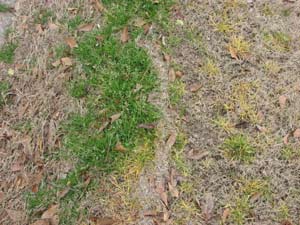Winter Poa Annua Control: The Missing Ingredient
Looking forward to another article about the latest chemistry to control Poa annua in the winter? If so, this article probably is not for you. To be sure, herbicides play a key role in keeping a golf course clean, but the secret ingredient is all-organic, 100% natural, and everyone has access to it. Unfortunately, the price can be high.
In building our case for the secret ingredient, this article will review our winter/spring travels and the successes/ failures we saw. Although most Poa annua is long gone, now is the time to plan for control in 2008-2009.
2007-2008: Failures and Successes in Weed Control
The winter and spring of 2007-2008 were typical as far as weed control is concerned. Poa annua is enemy number one and it likes to do battle in bermudagrass tees, fairways, and rough. Treatments began in late August 2007 and ended sometime in late March 2008. The level of control typically is not fully known until February or March.
 |
|
| Accuracy in spraying is crucial in winter weed control. Even the best herbicides will not be effective in areas where they are not placed. |
Levels of Poa annua control in the region have ranged from outstanding to unacceptable. There were no parts of the Southeast Region that were necessarily better than others. Golf courses could be separated geographically by a few miles with completely different levels of control.
When visiting a golf course with disappointing levels of control, we often hear several reasons. We will review these and offer our comments, too.
"The Herbicide Did Not Work or It Broke Down Too Quickly." - All the herbicides used for Poa annua control are thoroughly tested prior to being released and numerous weed scientists in the region have ongoing Poa annua control programs. It is unlikely that the herbicide did not work or it broke down too soon. It is far more likely that either the herbicide was not put down at the proper time or the turf manager expected control to last longer than is realistic.
"Our Poa Annua is Resistant to the Herbicides Used." - Please note that we are not weed scientists, but we do know that weed scientists advise that resistance is not likely to be a serious issue in less than seven years of using the same herbicide.
"It Was Too Wet To Spray." - This may be true. However, after reading about the secret ingredient, those managing golf courses that were too wet to spray may want to revisit this belief.
"The Bermudagrass is Not Dormant Enough to Spray Roundup." - This may be true, but just because one can find a semi-green stolon the third week of January does not mean Roundup is not a viable option. Dr. Fred Yelverton has conducted numerous trials on spraying semi-dormant bermudagrass (25% green) and the most damage he could induce was to delay greenup by a few weeks. Remember, bermudagrass did not become the number one agricultural weed in the world because it is easy to kill!
Introducing The Secret Ingredient
The secret ingredient is……. 'desire'. It is puzzling to visit two golf courses of similar budgets in the same week separated by only a few miles and see vastly different levels of Poa annua control. This winter, we made it a point to ask those superintendents with excellent Poa annua control what was their secret. They described a program that included products that everyone else had access to, but, most importantly, they said that having a weedy golf course in the spring was unacceptable. They added that the staff from the top down developed an attitude that they would do whatever it took to control Poa annua .
Be advised that there is a price to pay for the secret ingredient. Yes, there will be times when the herbicide used doesn't produce the desired results. The plan will need to be adjusted. There will be times when it is too wet to spray. A spray program will either need to be started earlier or some other solution will be needed. There may be parts of the golf course that are dry enough to spray and others too wet to spray. There may even be times when a nonselective herbicide needs to be sprayed when there is a small amount of green bermudagrass present. The secret ingredient will require questioning the entirety of the Poa annua program each year, staying up to date on the latest research, and making adjustments as needed.
Conclusion
The battle against Poa annua is an annual occurrence. Take the time to develop a program that is appropriate for your golf course. There are plenty of free resources. The NC State and Clemson University turf web sites can help develop a program for your location and budget. Ultimately, the secret ingredient, desire, must come from the golf course staff. With a great plan and the desire to have a clean golf course, Poa annua will not stand a chance.
Source: Patrick O'Brien 770-229-8125 or patobrien@usga.org and Chris Hartwiger 205-444-5079 or chartwiger@usga.org
